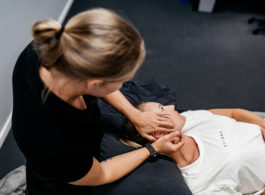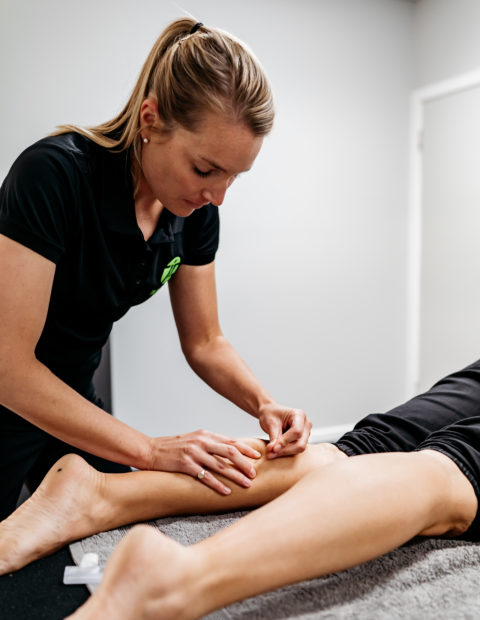
DRY NEEDLING GEELONG
Physiotherapists at The Injury Clinic Physiotherapy are all qualified and experienced in the use of dry needling as a treatment technique. Dry needling may be suggested, or offered, as a treatment option in the management of your injury.
Physiotherapists will discuss the reasons behind suggesting dry needling as a treatment option, as well as the expected outcomes.
What is Dry Needling?
Dry needling involves using a fine filament needle (the same as those used in acupuncture) to elicit a local twitch response from a muscle. It is most commonly used to address the health and function of muscle tissue.
A dry needle is used to target myofascial trigger points, or ‘knots’ in our muscle, and induce a local twitch response. Eliciting a local twitch response has been shown to improve the length, strength and fatiguability of a muscle. Dry needling to induce a local twitch response within a muscle, can therefore help in improving muscle and joint function.
Myofascial trigger points are extremely common, and their presence can result in disturbances in motor function such as muscle spasm, weakness, loss of coordination and decreased work tolerance. They will often occur as the result of muscle overload.



What to expect after treatment
Aside from a change to your symptoms, the following are normal responses after a treatment session involving dry needling;
- Muscle soreness: Quite common post treatment is for the muscle needled to feel tender, bruised, tight or heavy. Some people find they have no tenderness, others find it lasts up to two days after treatment.
- Fatigue or drowsiness: Some people feel drowsy after treatment. Again, this varies person to person and is also influenced by the volume of needling, the size of the muscle and the type of injury. This should settle quickly and most people report a great night sleep after needling!
- Bruising: Small bruises post treatment are common and usually settle quickly.
Why do Physiotherapists use Dry Needling?
There are many reasons why physiotherapists at The Injury Clinic may include dry needling as part of a management plan. These reasons include, but are not limited to:
– Addressing muscle dysfunction. Many of our muscles lay deep to those we can feel superficially (e.g. some of the gluteal muscles are more 5cm below the surface of the skin). Dry needling is much more effective than other forms of treatment (i.e. soft tissue / deep tissue massage) to address dysfunction in these muscles.
– To treat a persistent problem or injury. Dry needling is often used as a treatment progression from other forms of tissue release. It can be extremely effective in the treatment of injuries that haven’t responded to other forms of treatment.
– To assist with injury diagnosis. Some injuries are more complex than others. We often need to gauge the initial response to treatment to assist in accurate diagnosis and development of a management plan. With dry needling being incredibly effective in the treatment of muscle dysfunction, it may be used to assist in determining tissue sources involved in an injury presentation.



**If a Physiotherapist at The Injury Clinic has suggested dry needling, it is usually for one (or a combination) of these reasons. Ultimately, we feel dry needling be a more effective form of treatment for you. We are specific with who we suggest dry needling to, it is certainly not a form of treatment that is suited for everyone or every injury.
Explore our physiotherapy services
Musculoskeletal
Physiotherapy
At The Injury Clinic Physiotherapy, we work closely with our clients to get them back doing the things they love as soon as possible.
Sports
Physiotherapy
The Injury Clinic Physiotherapy works with recreational to elite athletes to keep them injury free and achieving their goals.
Dry
Needling
All physiotherapists at The Injury Clinic Physiotherapy are qualified and experienced in dry needling as a treatment technique.
Running Related Injuries
Physiotherapists at The Injury Clinic Physiotherapy have a special interest in the diagnosis and management of running-related injuries.
Women's Health
Physiotherapy
We have physiotherapists with a special interest in Women's Health, including pre and post partum presentations. Let us work with you to stay fit, active and healthy.
Pre & Post-Operative
Physiotherapy
Physiotherapists at The Injury Clinic Physiotherapy work closely with surgeons to ensure best outcomes post surgery.
Injury Q&A
Our clinicians have been answering all your questions!
Running Analysis
The goal of a running analysis is to identify aspects of your technique that may be contributing to injury or impacting on efficiency.






Schedule your next visit
If you’re interested in booking an appointment with one of our team members, contact our clinic today and we’ll be happy to find time for a consultation.
Schedule Consult